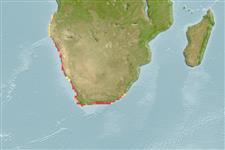Teleostei (teleosts) >
Blenniiformes (Blennies) >
Clinidae (Clinids)
Etymology: Clinus: Greek, klinein, kline = sloping and bed, due to the four apophyses of sphenoid bone (Ref. 45335).
More on author: Valenciennes.
Environment: milieu / climate zone / depth range / distribution range
Ecology
Marine; demersal. Subtropical; - 35°S
Southeast Atlantic: north of Swakopmund, Namibia to False Bay, South Africa.
Size / Weight / Age
Maturity: Lm ? range ? - ? cm
Max length : 13.0 cm TL male/unsexed; (Ref. 5496)
Dorsal spines (total): 30 - 32; Dorsal soft rays (total): 6 - 7; Anal spines: 2; Anal soft rays: 20 - 22. Dark irregular crossbars, speckled with white and dark blue; tips of anal and pelvic fins red, supraorbital tentacles and tips of dorsal fin white; blue-margined ocellus on shoulder (Ref. 5496).
Occurs in tide pools.
Life cycle and mating behavior
Maturities | Reproduction | Spawnings | Egg(s) | Fecundities | Larvae
Smith, M.M., 1986. Clinidae. p. 758-769. In M.M. Smith and P.C. Heemstra (eds.) Smiths' sea fishes. Springer-Verlag, Berlin. (Ref. 5496)
IUCN Red List Status (Ref. 130435)
Threat to humans
Harmless
Human uses
Tools
Special reports
Download XML
Internet sources
Estimates based on models
Preferred temperature (Ref.
123201): 15.5 - 22.5, mean 17.5 °C (based on 91 cells).
Phylogenetic diversity index (Ref.
82804): PD
50 = 0.5000 [Uniqueness, from 0.5 = low to 2.0 = high].
Bayesian length-weight: a=0.01096 (0.00423 - 0.02842), b=3.04 (2.82 - 3.26), in cm total length, based on LWR estimates for this (Sub)family-body shape (Ref.
93245).
Trophic level (Ref.
69278): 3.3 ±0.5 se; based on size and trophs of closest relatives
Resilience (Ref.
120179): High, minimum population doubling time less than 15 months (Preliminary K or Fecundity.).
Fishing Vulnerability (Ref.
59153): Low vulnerability (10 of 100).
